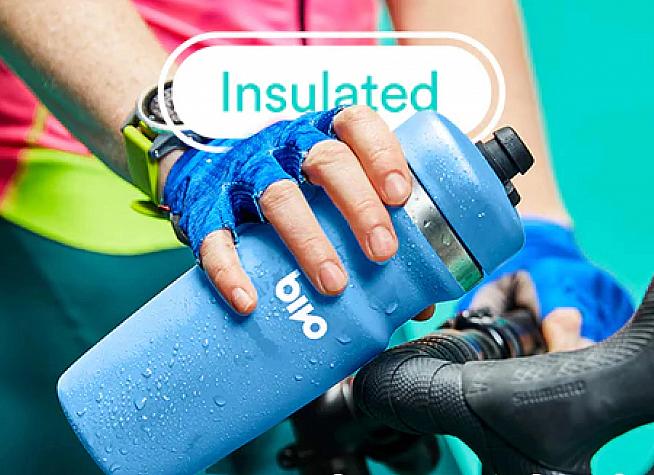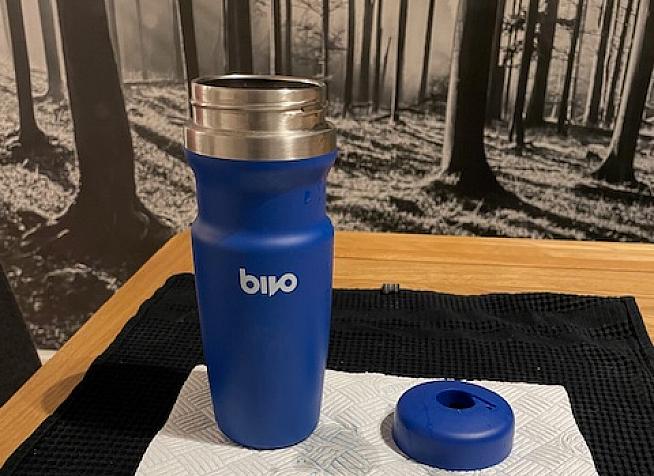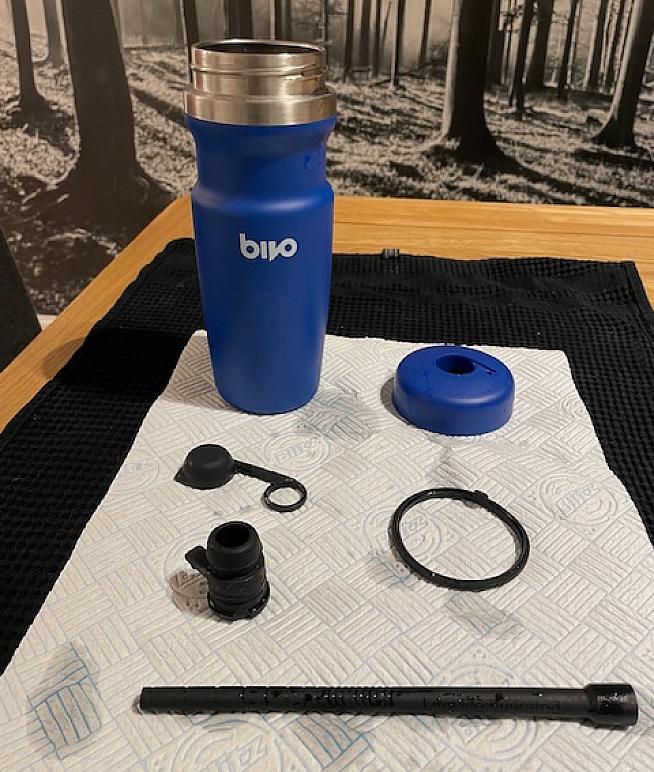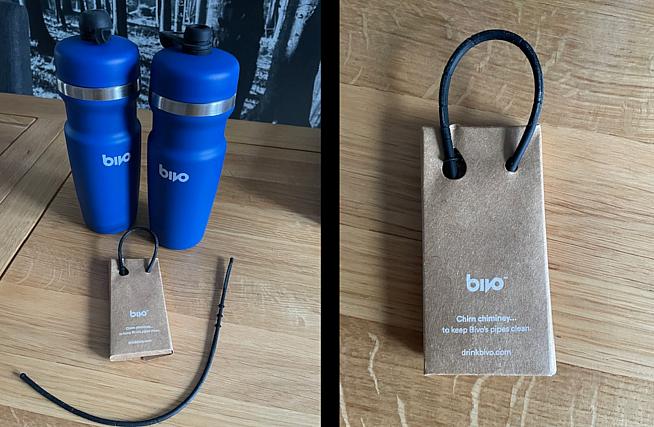Just as our 2023 cycling achievements are bought into some sort of focus on Strava, we can start to reflect on what sort of year it was: what was good, what was not so good? Could we have done more (always); and what would we do differently in the coming year?
One thing that 'bothered' me on a couple of my longer rides, 100 and 150 miles, was how the drinks I was carrying became so warm that I wasn't sure if they were aiding me in keeping hydrated and, because they were so warm and unpalatable, I was reluctant to take a drink so it was clearly just a case of carrying on and hoping for the best.
At the latter part of last year my interest was piqued by a piece I saw on 'Insterface' or 'Faceagram' about some stainless-steel bottles created by an American company called Bivo.

Stainless steel bottles aren't a new phenomenon but it's the first time I'd seen any that were cycling specific, so further investigation was required.
Bivo bottles came about because the founders, Carina Hamel and Robby Ringer, took a drink from their hydration backpack while skiing and found it distasteful and unpalatable, mouldy and plasticky; they decided there and then that there must be a better and healthier solution.
As cyclists were well known for their transportable drink bottles that was the first port of call for ideas, but it seemed that most of the available alternatives were the ubiquitous plastic bottles, and that didn't seem to address the issues, so a drawing board was required.
Replacing plastic was an obvious requirement, hence stainless steel, but what other issues would need to be addressed?
Squeezing the bottle to increase flow is not possible with stainless steel, so how do you create a sufficient flow of liquid?
From a cyclist's point of view, drinking from a bottle needs to be a one-handed opening and closing operation; stopping to have a glug is not a good thing.
Can a bottle be created that will fit, and be held, by conventional bike water bottle holders?
Finally, from a hygienic point of view, ease of cleaning has got to be a priority.
Over a period of 18 months many iterations of the bottle were developed, tested and rejected to arrive the present-day product, including some input from an engineer previously employed by NASA.
So how does it work?
To drink from the Bivo bottle all that's needed is to pull up the silicone drinking nozzle that allows air into the base of the bottle by, what appears to be, a straw and the water flows as the air is replaced. Simple!
All sounded very intriguing and so the next obvious thing was how do I get one?

The bottles are produced by a small team of six in Richmond, Vermont. Although Bivo offer free postage for purchases over $100 within America, shipping them to the UK does incur VAT at 20% and other taxes which can add as much as 18% to your bill, so be careful.
Fortunately for me I've got my buddy over there in Florida and as we were going across there just before Christmas I could place my order for a couple of bottles, plus one for my friend (well, it was Christmas after all).
The bottles come in various sizes and colours and can be ordered as insulated or non-insulated. I chose the insulated, soft touch, blue 17oz (500ml) version. To top off my order I added 'Dusty the Dust cap' (a $5 add-on): this is a cap that fits onto the drinking aperture so that I don't pick up any nasties when I'm pedalling around. The dust caps also come in different colours.
By the time we'd got back home and Christmas was out of the way, it was time to see how to me and the bottles would get on.
The first thing to do, as with any new bottle, is to give them a rinse and a bit of a clean out just to get shot of any manufacturing residue.
Having filled and shaken the liquid it seemed like a good opportunity to try and see if the emptying speed lives up to the Bivo video claim of emptying in 10 seconds; why would they spin a yarn, it does. Constant flow with no effort on my part, just pull up on the silicone nozzle tip the bottle upside down and away you go, full flow.
That's great, but how would it perform on the bike? Another 'issue' that I thought of is that I like to be able to see the contents of my bottles as I'm riding so that I can a) monitor my hydration and b) make sure I know when to make a drink stop. As stainless steel is not see-through would that create a problem or, to be more precise, require a little more planning and paying a bit more of attention along the ride?
A major part of the research that Bivo carried out was trying out various shapes and formats to ensure that the bottles would fit securely into bottle cages without being shaken loose whilst out on the road.
With the storms and terrible weather we experienced here in the UK towards the end of 2023 I opted for the Wattbike, as opposed to the road bike, so this gave me a golden opportunity to check the bottle cage fit and trying out drinking from the bottles on a static, stable, format before venturing outdoors.
The bottle cage fit was a straightforward success on the Wattbike and my two road bikes, bonus. Bivo recognise the fact that on some bottle cage fittings the attachment screws can sit proud of the cage mount and therefore scratch the bottle surface and so they kindly supply a couple of flush fitting screws with each bottle, just in case.
I found that the process of lifting the dust cap and the silicone nozzle was easily combined in one procedure by using my teeth but not too strongly though. Drinking was easy, full flow, no squeezing the bottle and no loss of breath whilst taking on fuel. More practice required though.
Closing the bottle took a little more practice, i.e. pushing the nozzle and dust cap back in place, but it was quite easy and after a few sessions and road miles it'll be as easy as drinking from a normal bottle.
Because I was cycling indoors and only using hydration tablets the post-ride clean was just a matter of giving the bottles a quick swill through and leaving them to drain. I used hot water but noticed that even though the bottle was full the external part was still cool to touch i.e. well insulated, happy days.
For obvious reasons Bivo recommend that you do not use the bottles for hot liquids and I'm sure you can imagine the outcome of glugging on a hot liquid, it will definitely spoil your ride.
Thankfully the weather eventually cheered up but was still very cold, suitable clothing required, so it was time to see if my drink bottle training sessions worked.
My energy drink of choice, Elivar, mixes a little thicker than other drinks I've used so, once again, it would be interesting to see if that made any difference to taking in the fluids? Answer, none. Lift the nozzle, tip up and grab the flow.
And despite my initial concerns about not having a visual reference to my bottle contents, it wasn't an issue at all, the decreasing weight of the bottles was a fair indication.


Post-ride the effectiveness cleaning the bottles was the next focus point. Bivo have created an easy-to-follow video covering the process.
All bottles are dishwasher safe, although Bivo recommend cleaning the cap by hand.
The main body is stainless steel, of course, and the nozzle, straw and other components are made from food grade silicone. Prior to cleaning the whole of the assembly can easily be dismantled and reassembled afterwards.
Even though the silicone straw is in place to channel the air into the bottom of the bottle and shouldn't transport any liquids Bivo also supply a natty little brush that is used to 'pull through' the straw as an extra aid to cleaning, and it works a treat.
All in all, I think Bivo have achieved the goals that they set themselves. The bottles are functional, easy and safe to use, easy to clean and environmentally friendly, big ticks all round.
The only problem for customers outside the USA is the extra tax and import duties that must be added to the initial cost. If there any budding entrepreneurs out there it might be a business opportunity waiting to happen.
As for me, I'm thinking of ordering another one or two, or even one of the larger sizes so that I can pick them up when we visit our friends again in May.
Bivo Trio Mini, $44 from drinkbivo.com
0 Comments





